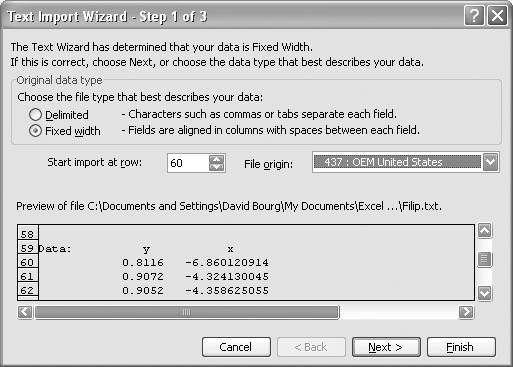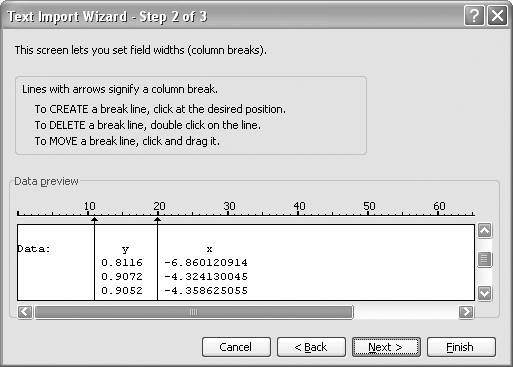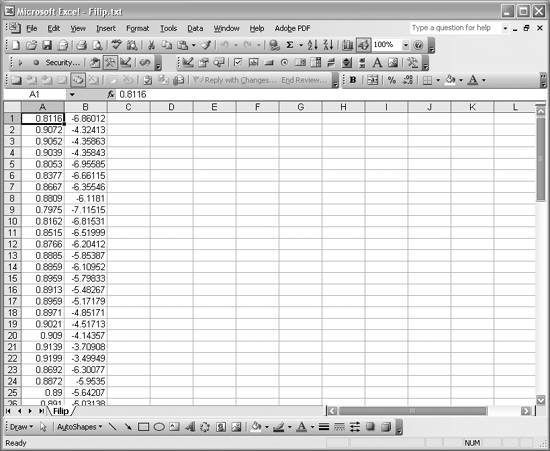Importing Data from Text Files
Problem
You have some data you'd like to analyze in Excel but it's located in a separate text file.
Solution
Open the text file in Excel using File images/U2192.jpg border=0> Open....
Discussion
Excel is capable of reading many different file formats, not just Excel spreadsheet files. Opening a text file is very much like opening a spreadsheet file: simply use File images/U2192.jpg border=0> Open... (or use the shortcut Ctrl-O) to pull up the Open dialog box and select the file you wish to open. Figure 3-1 illustrates the Open dialog box.
Figure 3-1. Open dialog box

The Open dialog box defaults to listing only Microsoft Excel files (with extensions .xls, .xla, and so on). To list text files (with the .txt extension), you'll have to select Text Files in the "Files of type" drop-down listbox, as shown in Figure 3-1. Press the Open button after selecting the file you wish to open.
|
Upon pressing the Open button, you'll see the Text Import Wizard dialog box shown in Figure 3-2. Since text files aren't necessarily in a format consistent with tidy rows and columns, Excel provides this import wizard to assist with parsing text, so the data you're after ends up in rows and columns in the newly formed spreadsheet. The wizard treats every line in the text file as a row of data. It then allows you to specify where column breaks should go so your data ends up in rows and columns. If you skip the column specification part, you could end up with rows of data in a single column, with each cell in the column potentially containing long strings of text.
Figure 3-2. Text Import Wizard: Step 1

Specifying column breaks is fairly painless. The first thing you need to do is specify whether your data is in delimited or fixed-width form. Delimited means the data on each row is separated by characters such as commas, spaces, tabs, or semicolons. Fixed width means the sets of data on each row are already aligned in columns, with spaces separating the columns. The data I'm using in this example is fixed width, as shown in Figure 3-2. See Recipe 3.2 to learn how to work with delimited data .
Notice the row numbers to the left of the data previewed in Figure 3-2. The text file actually contains some descriptive information at the beginning of the file that, while useful, is not what I'm really interested in importing. Therefore, I've scrolled down to row 60 in the preview window so I can see the actual data. I've also set "Start import at row" to 60 so all the lines above the actual data will be skipped.
At this point, you should press the Next button to advance to the next step in the import wizard. Doing so opens the dialog box for step 2 shown in Figure 3-3.
In this step you actually specify your desired column breaks. The import wizard usually makes a pretty good guess for you, and often you don't have to do anything else. In some cases, a few tweaks are in order. Specifying column breaks is easy and the dialog box shown in Figure 3-3 actually includes instructions. Simply click at a point along the ruler just above the data preview window to set a column break. Double click a break to delete it. Or, click and drag to reposition a break. It's that simple. Click Next to proceed to the third step once your breaks are set. Figure 3-4 shows the dialog box for step 3.
Figure 3-3. Text Import Wizard: Step 2

Figure 3-4. Text Import Wizard: Step 3

The third step allows you to specify the data type, or format, of the data contained in each column you specified in the previous step. Simply click any column in the data preview window to select the column. Next, specify the data format for that column by pressing one of the "Column data format" radio buttons. To be honest, I usually skip this step and use the defaults set by the wizard. The wizard usually does a fine job recognizing text versus numbers. I find this step most useful when I want to skip a column. For example, the first column in Figure 3-4 does not contain any data; it contains only one row of text. Therefore, I select it and specify "Do not import column."
At this point you should press Finish to exit the wizard. Excel will then import the text per your specifications. The results for this example are shown in Figure 3-5.
Figure 3-5. Imported text

As you can see, Excel imported only the data I specified, placing it in columns A and B of a new spreadsheet. Now you can perform any of the usual spreadsheet operations on this data and save the resulting spreadsheet as you normally would. Before going too far, I recommend you do a Save As (File images/U2192.jpg border=0> Save As...) and save the new spreadsheet as a spreadsheet file with the .xls extension. This way, you can be sure to avoid overwriting your original text file. (Excel will warn you anyway if you attempt to overwrite it.)
See Also
See Recipes 3.2, 3.3, 3.4, and 3.5 for alternative data-importing techniques.
Using Excel
- Introduction
- Navigating the Interface
- Entering Data
- Setting Cell Data Types
- Selecting More Than a Single Cell
- Entering Formulas
- Exploring the R1C1 Cell Reference Style
- Referring to More Than a Single Cell
- Understanding Operator Precedence
- Using Exponents in Formulas
- Exploring Functions
- Formatting Your Spreadsheets
- Defining Custom Format Styles
- Leveraging Copy, Cut, Paste, and Paste Special
- Using Cell Names (Like Programming Variables)
- Validating Data
- Taking Advantage of Macros
- Adding Comments and Equation Notes
- Getting Help
Getting Acquainted with Visual Basic for Applications
- Introduction
- Navigating the VBA Editor
- Writing Functions and Subroutines
- Working with Data Types
- Defining Variables
- Defining Constants
- Using Arrays
- Commenting Code
- Spanning Long Statements over Multiple Lines
- Using Conditional Statements
- Using Loops
- Debugging VBA Code
- Exploring VBAs Built-in Functions
- Exploring Excel Objects
- Creating Your Own Objects in VBA
- VBA Help
Collecting and Cleaning Up Data
- Introduction
- Importing Data from Text Files
- Importing Data from Delimited Text Files
- Importing Data Using Drag-and-Drop
- Importing Data from Access Databases
- Importing Data from Web Pages
- Parsing Data
- Removing Weird Characters from Imported Text
- Converting Units
- Sorting Data
- Filtering Data
- Looking Up Values in Tables
- Retrieving Data from XML Files
Charting
- Introduction
- Creating Simple Charts
- Exploring Chart Styles
- Formatting Charts
- Customizing Chart Axes
- Setting Log or Semilog Scales
- Using Multiple Axes
- Changing the Type of an Existing Chart
- Combining Chart Types
- Building 3D Surface Plots
- Preparing Contour Plots
- Annotating Charts
- Saving Custom Chart Types
- Copying Charts to Word
- Recipe 4-14. Displaying Error Bars
Statistical Analysis
- Introduction
- Computing Summary Statistics
- Plotting Frequency Distributions
- Calculating Confidence Intervals
- Correlating Data
- Ranking and Percentiles
- Performing Statistical Tests
- Conducting ANOVA
- Generating Random Numbers
- Sampling Data
Time Series Analysis
- Introduction
- Plotting Time Series Data
- Adding Trendlines
- Computing Moving Averages
- Smoothing Data Using Weighted Averages
- Centering Data
- Detrending a Time Series
- Estimating Seasonal Indices
- Deseasonalization of a Time Series
- Forecasting
- Applying Discrete Fourier Transforms
Mathematical Functions
- Introduction
- Using Summation Functions
- Delving into Division
- Mastering Multiplication
- Exploring Exponential and Logarithmic Functions
- Using Trigonometry Functions
- Seeing Signs
- Getting to the Root of Things
- Rounding and Truncating Numbers
- Converting Between Number Systems
- Manipulating Matrices
- Building Support for Vectors
- Using Spreadsheet Functions in VBA Code
- Dealing with Complex Numbers
Curve Fitting and Regression
- Introduction
- Performing Linear Curve Fitting Using Excel Charts
- Constructing Your Own Linear Fit Using Spreadsheet Functions
- Using a Single Spreadsheet Function for Linear Curve Fitting
- Performing Multiple Linear Regression
- Generating Nonlinear Curve Fits Using Excel Charts
- Fitting Nonlinear Curves Using Solver
- Assessing Goodness of Fit
- Computing Confidence Intervals
Solving Equations
- Introduction
- Finding Roots Graphically
- Solving Nonlinear Equations Iteratively
- Automating Tedious Problems with VBA
- Solving Linear Systems
- Tackling Nonlinear Systems of Equations
- Using Classical Methods for Solving Equations
Numerical Integration and Differentiation
- Introduction
- Integrating a Definite Integral
- Implementing the Trapezoidal Rule in VBA
- Computing the Center of an Area Using Numerical Integration
- Calculating the Second Moment of an Area
- Dealing with Double Integrals
- Numerical Differentiation
Solving Ordinary Differential Equations
- Introduction
- Solving First-Order Initial Value Problems
- Applying the Runge-Kutta Method to Second-Order Initial Value Problems
- Tackling Coupled Equations
- Shooting Boundary Value Problems
Solving Partial Differential Equations
- Introduction
- Leveraging Excel to Directly Solve Finite Difference Equations
- Recruiting Solver to Iteratively Solve Finite Difference Equations
- Solving Initial Value Problems
- Using Excel to Help Solve Problems Formulated Using the Finite Element Method
Performing Optimization Analyses in Excel
- Introduction
- Using Excel for Traditional Linear Programming
- Exploring Resource Allocation Optimization Problems
- Getting More Realistic Results with Integer Constraints
- Tackling Troublesome Problems
- Optimizing Engineering Design Problems
- Understanding Solver Reports
- Programming a Genetic Algorithm for Optimization
Introduction to Financial Calculations
- Introduction
- Computing Present Value
- Calculating Future Value
- Figuring Out Required Rate of Return
- Doubling Your Money
- Determining Monthly Payments
- Considering Cash Flow Alternatives
- Achieving a Certain Future Value
- Assessing Net Present Worth
- Estimating Rate of Return
- Solving Inverse Problems
- Figuring a Break-Even Point
Index
EAN: 2147483647
Pages: 206

